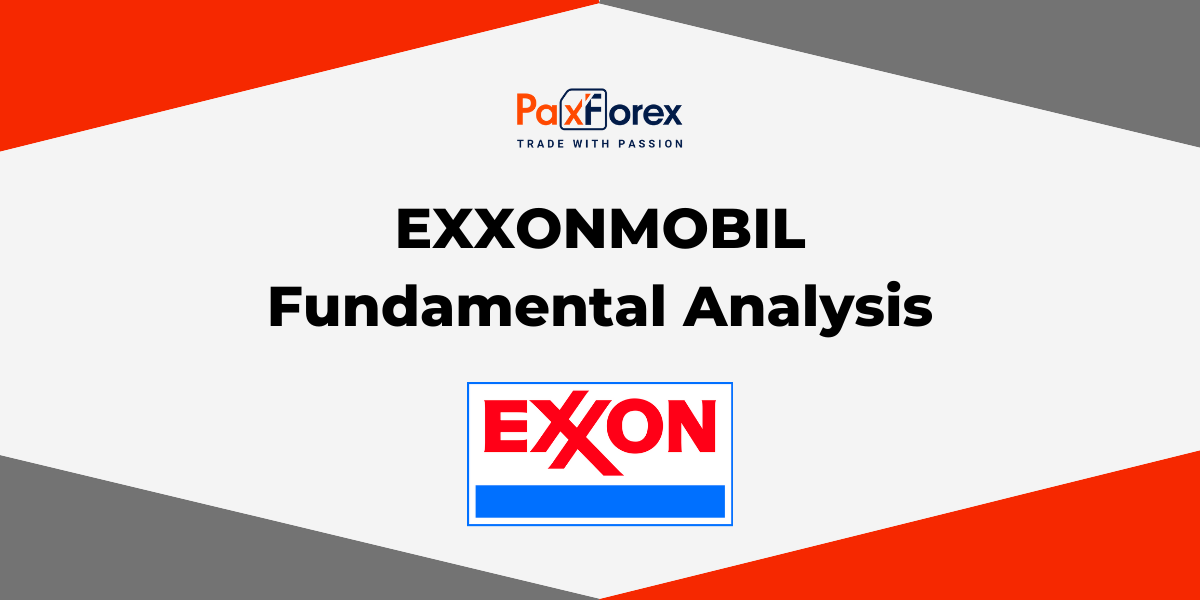
Source: PaxForex Premium Analytics Portal, Fundamental Insight
ExxonMobil | Fundamental Analysis
ExxonMobil, an energy juggernaut with a market capitalization of $460 billion, scarcely requires an introduction. It ranks among the world's largest producers of oil and natural gas. With a generous dividend yield of 3.1%, significantly surpassing the S&P 500's modest 1.5% average, this behemoth warrants close scrutiny from income-focused investors.
Here's why ExxonMobil emerges as an unequivocal dividend gem for those seeking energy stocks.
When searching for a dependable dividend investment, the volatile energy sector isn't typically the first place one looks. Performance within this sector can exhibit rapid and substantial swings, oscillating between substantial profits and painful losses. There are relatively few dividends that can endure such pronounced fluctuations.
Yet, ExxonMobil stands as a remarkable exception, having augmented its dividend every year for an impressive 41 consecutive years—an unparalleled feat. Take a moment to contemplate this achievement.
While it's unsurprising that ExxonMobil could bolster its dividend in a year like 2022, when oil prices surged to $120 per barrel, the real testament to its dividend strength lies in its performance during the tumultuous year of 2020. This was a year marred by pandemic-induced economic shutdowns that sent oil prices plummeting to unprecedented lows. At one point, the price of a barrel of West Texas Intermediate crude, a key U.S. energy benchmark, even dipped below zero. Remarkably, ExxonMobil remained steadfast, concluding the year with a dividend higher than the preceding one.
Evidently, ExxonMobil and its board exhibit an unwavering commitment to rewarding investors with consistent dividend increments. The proof lies in this remarkable streak of dividend growth. If you prioritize dividend reliability in your investment strategy, this stalwart in the world of passive-income energy companies should unquestionably top your list of energy stocks to consider.
Before delving into an investment in ExxonMobil, it's essential to grasp how the company achieves its remarkable dividend consistency. The key lies within its balance sheet, where a significant piece of the puzzle comes together. Illustrated by the chart below, ExxonMobil maintains an exceedingly modest debt-to-equity ratio of 0.2. This level of leverage is low by any measure and ranks as the second lowest among ExxonMobil's closest peers. However, this is only the beginning.
A robust financial bedrock affords a company the much-needed flexibility to navigate through challenging times. Given that fluctuations in the energy sector are a regular occurrence in ExxonMobil's operational sphere, it's logical for the company to prioritize maintaining a sturdy balance sheet. The true magic emerges when energy prices experience downward spirals.
During the oil price collapse in 2020, ExxonMobil's leverage did indeed rise, a trend that was widespread within its peer group. However, what set ExxonMobil apart was its ample room to incur debt compared to most of its competitors. This debt was strategically employed to support the business and sustain the dividend. While some of its industry peers were forced to trim their dividends, ExxonMobil did not find it necessary. Notably, as oil prices rebounded, ExxonMobil promptly reduced its leverage, positioning itself to face the next industry downturn with resilience.
ExxonMobil may not boast the highest yield among energy stocks, yet it stands as an industry titan with a consistent track record of adeptly navigating the sector's inherent volatility while consistently rewarding dividend investors. If you seek a dependable dividend-paying energy stock, ExxonMobil should undoubtedly occupy the top spot on your list. After examining ExxonMobil, you'll likely find yourself comparing all other options to it. Ultimately, you may circle back to where you began—with the industry behemoth ExxonMobil as your premier choice.
As long as the price is above 115.00, follow the recommendations below:
- Time frame: D1
- Recommendation: long position
- Entry point: 117.47
- Take Profit 1: 120.00
- Take Profit 2: 125.00
Alternative scenario:
If the 115.00 level is broken-down, follow the recommendations below:
- Time frame: D1
- Recommendation: short position
- Entry point: 115.00
- Take Profit 1: 112.00
- Take Profit 2: 109.00













